Alliance Focuses on School-Age Kids
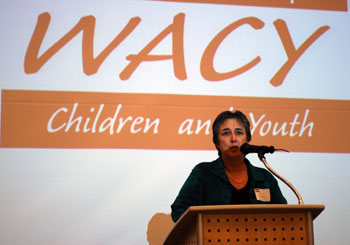
Joan Doughty kicked off a recent forum of the Washtenaw Alliance for Children and Youth. Doughty is executive director of the Community Action Network and a WACY steering committee member. (Photo by the writer.)
In January 2008, the Washtenaw United Way announced plans to focus its funding on five areas: early childhood education and care, aging in place, food, shelter and access to health care. While they didn’t quibble with the importance of those goals, local nonprofits that work with older children were stunned that funding for K-12 kids, especially those who lived in poverty, hadn’t made the cut.
In an op/ed piece published in the April 2, 2008 Ann Arbor News, Joan Doughty, executive director of the Community Action Network, put it this way: “Nonprofit directors like myself who coordinate programs providing academic and life skills and social support to low-income and youth at risk ages 6 and up were astonished and devastated to find that this area was not represented as an established priority.”
The decision by Washtenaw United Way mobilized leaders of about 20 groups that work with school-aged children – the result is the Washtenaw Alliance for Children and Youth (WACY), a coalition that had its coming-out party at a community forum two weeks ago.
Doughty is one of the lead organizers for this group and a member of its steering committee. She told the forum – about 200 people gathered at Washtenaw Community College – that the community didn’t previously have a comprehensive structure in place to focus on that age group. “We also realized that while many of us knew parts of how children were doing – for example, the public health piece, or the education piece, or juvenile justice – none of us had the big picture,” she said.
They recognized that data collection was key, Doughty said – one of the working groups they established focused on that, and preliminary findings were presented at the Sept. 29 forum. The assessment aims to provide metrics that identify areas needing additional work and resources. The overall goal? To ensure that all children, by the time they reach age 21, are ready for college, work and life.
Bonnie Billups, Jr., the executive director of Peace Neighborhood Center and a WACY steering committee member, acknowledged the ambition of that goal. “That’s a gigantic task,” he said, “but we’re up to it.”
Data Collection: Ready by 21
To assess the current status of youth in Washtenaw County – and to measure progress in several areas going forward – WACY is using an approach called Ready by 21, originally developed by the nonprofit Forum for Youth Investment. The model includes charts for five broad categories: Learning, thriving, working, connecting and leading. For each category, data relevant to that category is collected for five age groups: early childhood (ages 0-5), elementary (ages 6-10), middle school (ages 11-13), high school (ages 14-18) and young adult (ages 19-24).
Each category has a goal. The goal for the “thriving” category, for example, is this: “All Washtenaw County children and youth will be healthy through access to resources and practice of good health habits.” The chart below, which links to a higher resolution image, shows the different measures being used to assess this category. The findings are color-coded, with red as the most critical, yellow as a cautionary status and green as doing well. For some areas, there’s not enough data available to make an assessment.
One measure in the “thriving” category is the number of free and reduced lunches that are served to children in local school districts. The overall average, combining all districts, is 22% – but in some districts, that percentage is much higher. In Willow Run, 72% of school-aged children receive free or reduced lunches. The lowest district is Saline, at 6%. In Ann Arbor Public Schools, 19% of students receive free or reduced lunches. Overall, this data point is given a critical status.
Also getting a critical status is the percentage of chlamydia cases for the county’s high school students (37%) and young adults (39%), out of the 1,194 cases reported in 2008. The “thriving” category also measures child poverty, the percentage of children with depression or suicidal thoughts, substance abuse and weight.
Here’s an overview of the data collected to assess other categories:
Learning
Goal: All Washtenaw County youth will have an effective education that promotes life-long learning. Metrics: 1) average school attendance, 2) scores in math, reading and writing for the Michigan Educational Assessment Program (MEAP), 3) high school completion, and 4) completion of a two- or four-year degree within five years of graduating high school
Working
Goal: All Washtenaw County youth will have the knowledge and skills needed for the 21st century. Metrics: 1) percentage of children with no full-time, year-round employed adults at home, 2) participation in job shadowing or mentoring, 3) teens not in school and unemployed, and 4) local unemployment rate.
Connecting
Goal: All Washtenaw County youth will make positive choices and are safe and supported in their families and communities. Metrics: 1) school safety (experiencing harassment or physical violence), 2) delinquency, 3) neglect/abuse, 4) extracurricular participation, and 5) having a supportive adult in their lives.
Leading
Goal: All Washtenaw County youth will be valued contributors in the community process. Metrics: 1) community service during the school year, 2) community service during the summer, 3) participation in political action groups, and 4) participation in student government.
[.PDF of full WACY Status Report]

Lisa Greco and Jeremy Keeney examine data during the Sept. 29 Washtenaw Alliance for Children & Youth forum. Greco is director of Washtenaw County's children's services department. Keeney, a University of Michigan student, is a school board member for the Lincoln Consolidated School District. (Photo by the writer.)
In giving an overview of the report, J.T. Todd – assistant director of the Center for Occupational and Personalized Education (COPE) in Ypsilanti and a WACY steering committee member – described the data collection as a work in progress. They had gathered information from over a dozen sources, she said, including the county juvenile court and department of public health, state data from Kids Count, the U.S. Census, the Washtenaw Intermediate School District and others. She clarified that they didn’t collect information for kids aged 0-6 years, because another coalition, Success by Six, focuses on that age group.
Todd also said that what they didn’t have – but what they hoped to gather eventually – was more data that included racial and gender breakouts, as well as more district-level information. And she noted that this was a one-year snapshot. Going forward, they’ll be able to track trends as well.
The Sept. 29 forum was meant to get feedback on what WACY had done so far, Todd said. “This is just the beginning of a conversation.”
Next Steps
The alliance recently received a $25,000 grant from the Michigan Committee on Juvenile Justice, which will pay for a staff position to work on WACY’s action plan. Laura Scott has been hired to do that, with the plan to be completed by January.
Todd also invited people “who like to geek out with data” to a Dec. 2, 2009 session that will take a closer look at the information being gathered for this status report. That event will be held from noon to 2 p.m. at the county’s Learning Resource Center, 4135 Washtenaw Ave., at the corner of Washtenaw and Hogback.
In wrapping up the Sept. 29 session, Bonnie Billups, Jr. of Peace Neighborhood Center urged forum attendees to get involved in one of the working groups, and to spread the word about WACY’s work. So far, 22 groups have joined the alliance. They are:
- 826michigan
- Ann Arbor Community Center
- Ann Arbor Public Schools Rec & Ed
- Arrowwood Hills Housing Cooperative
- Community Action Network
- Center for Occupational & Personalized Education (COPE)
- Education Project for Homeless Youth
- Family Learning Institute
- Huron Valley Boys & Girls Club
- Jewish Family Services
- Neutral Zone
- Ozone House
- Peace Neighborhood Center
- Planned Parenthood
- SOS Community Services
- The Corner Health Center
- University of Michigan Regional Alliance for Healthy Schools
- Washtenaw Area Council for Children
- Washtenaw Camp Placement Association
- Washtenaw County Community Support & Treatment Services (CSTS)
- Washtenaw County Trial Court
- Washtenaw Youth Development Initiative

Laura Scott, left, has been hired to develop an action plan for the Washtenaw Alliance on Children & Youth. (Photo by the writer.)
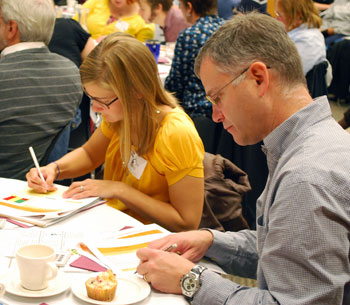
Catherine Gorga with the UM Health System Child Care Center and Marcos Anders of SOS Community Services fill out feedback cards at the Sept. 29 Washtenaw Alliance for Children & Youth forum.
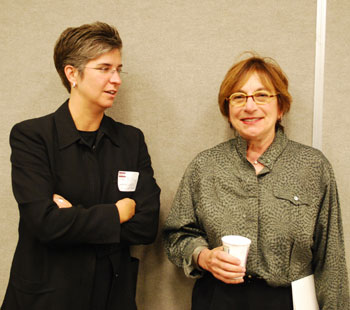
Mary Jo Callan, director of the Ann Arbor/Washtenaw Office of Community Development, left, with Cynthia Maritato, director of the Washtenaw County Department of Human Services.

Bonnie Billips, Jr., executive director of Peace Neighborhood Center, and Joan Doughty, executive director of Community Action Network. Both are on the steering committee for the Washtenaw Alliance for Children & Youth.




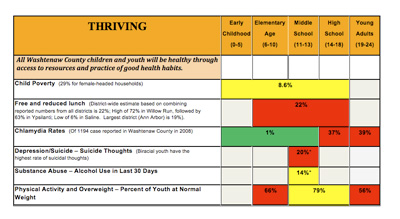

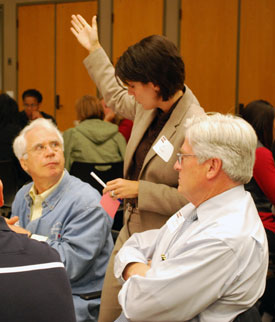
Perhaps they may consider finding a different name for the organization. W-A-C-Y is too close to wacky, a quality too often attributed to AA area social service organizations.
In her opening remarks, Joan Doughty mentioned they’d originally thought that WACY (which they do pronounce “wacky”) would be an interim name, but that it stuck. She said it fits their constituency of kids and teens.
This article embodies the true spirit of the WACY forum: many youth serving agencies coming together for the purpose of promoting data driven decisions, and moving forward as a unified force with a common set of goals.